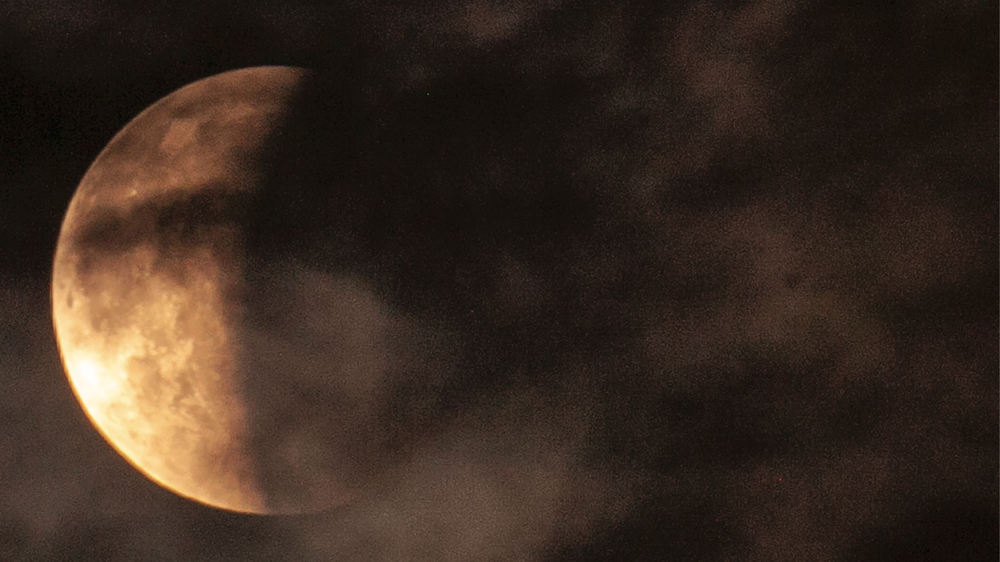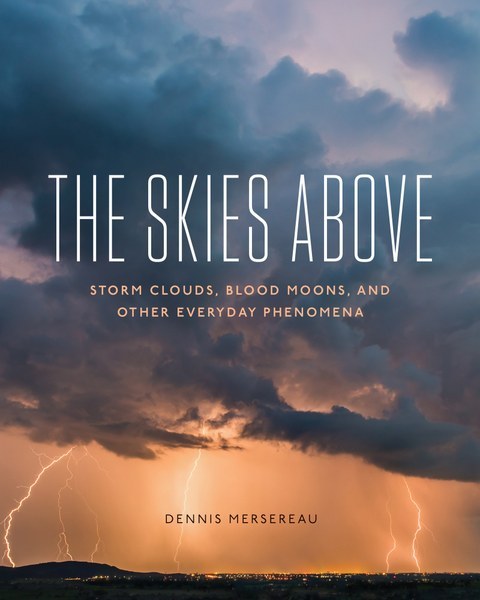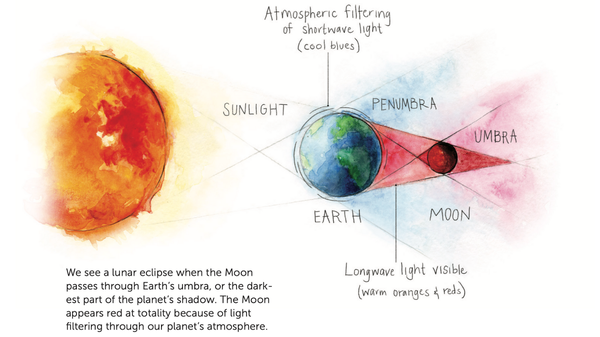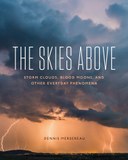
This May 15, 2022, there will be a total lunar eclipse. In our hometown of Seattle it will be between 8:34pm and 11:50pm, with the maximum eclipse occurring at 9:11pm. Learn about lunar eclipses with this excerpt from The Skies Above: Storm Clouds, Blood Moons, and Other Everyday Phenomena by Dennis Mersereau.
 "A breathtaking astronomical event, a lunar eclipse is one of the easiest to enjoy. You don’t need a telescope, a pair of special glasses, or complete darkness in order to witness the surface of the Moon slowly fading to a dark shade of red. As long as you have a clear view of the sky without any clouds in your way, you can easily see the Earth’s shadow obscure the Moon.
"A breathtaking astronomical event, a lunar eclipse is one of the easiest to enjoy. You don’t need a telescope, a pair of special glasses, or complete darkness in order to witness the surface of the Moon slowly fading to a dark shade of red. As long as you have a clear view of the sky without any clouds in your way, you can easily see the Earth’s shadow obscure the Moon.
A lunar eclipse is the result of a syzygy, a delightfully fun word that describes the linear alignment of the Sun, the Earth, and the Moon. This occurs when the Earth moves between the Sun and the Moon, casting its shadow on the lunar surface. The size of the Earth relative to the Moon means a lunar eclipse lasts a couple of hours from beginning to end, giving observers plenty of time to head outside and enjoy the view.

Earth’s shadow isn’t uniformly dark. The Sun is enormous, so our planet receives sunlight from every visible point on the star’s surface. In addition to direct sunlight, we also receive light on a slight angle from the outer edges of the Sun’s disk. This causes the Earth to cast a shadow on the Moon that’s faint on its edges and grows progressively darker toward the middle. You can see this effect in your own home. When you turn on a light, objects near it don’t cast a single, sharp shadow on the wall; instead, they cast a dark shadow that gradually grows fuzzier and fainter around the edges.
To get technical, the faint edges of the Earth’s shadow are called its penumbra, while the dark center of the shadow caused by blockage of the Sun’s direct light is called the umbra. A total lunar eclipse takes place when the Moon passes directly through the umbra, while a partial lunar eclipse sees the Earth’s umbra clip only a portion of the lunar surface. Penumbral eclipses are more common than umbral eclipses, but the shadow is so faint that it’s hard for most people to notice a difference in the brightness of the Moon.
Total lunar eclipses, or umbral eclipses, are the most impressive of the bunch. The first glimpse of our planetary obstruction is a thin crescent shadow that appears on the corner of the Moon. This sliver of darkness will eventually grow to encompass the entire body itself, bathing the lunar surface with a dark red shadow that looks as though the Moon were on fire. In some cases, totality can last more than an hour before the shadow moves on, allowing the Moon to slowly regain sunlight until its orbit fully escapes the Earth’s umbra.
BLOOD MOON: A total lunar eclipse is occasionally called a blood moon due to the reddish tint that bathes the Moon as it falls behind the Earth’s shadow. The term grew popular after Christian evangelical pastor John Hagee released the book Four Blood Moons: Something Is about to Change in 2013. The pastor argued that the four total lunar eclipses visible in 2014 and 2015 were fulfillment of a Biblical prophecy that heralded the impending arrival of the end times. While the term’s modern popularity apparently began after the release of Hagee’s book, it’s common for news organizations to refer to lunar eclipses as blood moons as a snappy way to advertise the astronomical event on social media.
The reddish tint on the Moon during the height of a total lunar eclipse occurs for the same reason we see a beautiful display of colors at sunrise and sunset. Sunlight scatters as it filters through Earth’s atmosphere. The individual waves of visible light emanating from the Sun bump up against all the gases and pollutants that fill our atmosphere, slowly filtering out shortwave light like the color blue, while longwave colors like orange and red are able to slip through without getting filtered out. Sunlight during an eclipse has to pass through almost the entire atmosphere to reach the Moon, allowing only the deepest shades of red to reach the lunar surface.
Lunar eclipses are possible only during a full moon, or when the Moon is on the dark side of the Earth. The full moon appears in the sky at sunset and sinks below the horizon at sunrise. The bright moonlight that bathes the Earth’s surface with its revealing glow doesn’t come from the Moon itself but rather from sunlight reflecting off the dust and rocks that make up the lunar surface. It’s impressive how brightly the Moon can illuminate the night sky given that it’s only a reflection!
If we can see a lunar eclipse during a full moon, then why don’t we see them every month? The Moon’s orbit around the Earth isn’t flat; it’s actually tilted by a couple of degrees, meaning the Moon passes above or below the Earth’s shadow most of the time. The Moon’s orbit rarely takes it through some or all of our planet’s shadow.
The Moon’s small size and slightly tilted orbit makes solar eclipses even rarer than lunar eclipses. A solar eclipse occurs during the new moon, when the Moon passes directly between the Sun and the Earth at just the right angle so that the Moon casts a shadow on the Earth’s surface.
As each total lunar eclipse is visible by about half of the world, the average person will likely have the opportunity to see dozens of lunar eclipses during their lifetime. Seeing a total solar eclipse is much rarer because the Moon’s shadow covers only a relatively tiny portion of the Earth’s surface. On average, any one spot on Earth gets to see a total solar eclipse once every 375 years, but the same spot has the chance to witness a total lunar eclipse once every two years or so."
Photo credit: Moon image by Octavian Cocolos
 Mountaineers Books
Mountaineers Books
